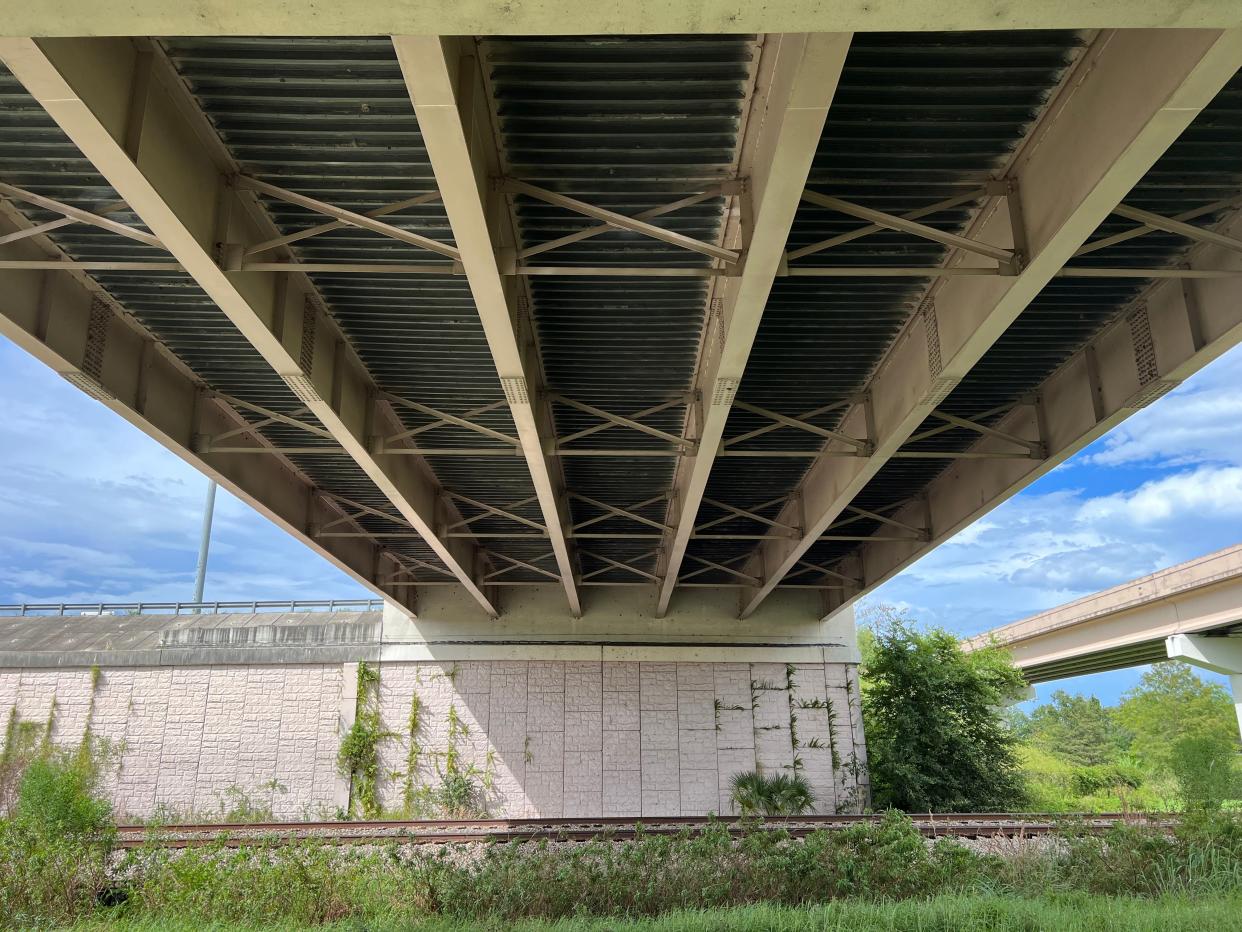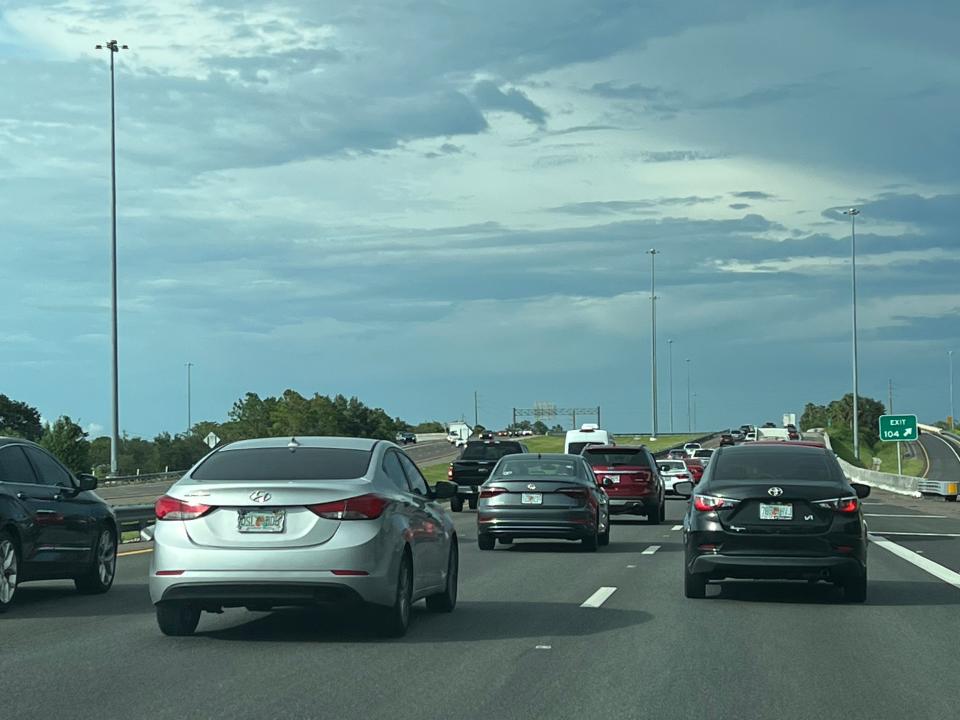Who needs haunted houses? What to know about I-4's 'Dead Zone,' Florida's haunted highway

- Oops!Something went wrong.Please try again later.
- Oops!Something went wrong.Please try again later.
When most people complain about Interstate 4, running just over 132 miles from Tampa to Daytona Beach, they're annoyed with the traffic, the wrecks, and the confusing and constant construction.
But locals in the Sanford area know it's haunted, and possibly cursed.
Commuters driving through the quarter-mile stretch of highway roughly halfway between Orlando and Daytona Beach leading onto the St. Johns River Bridge over Lake Monroe have reported a sudden drop in phone reception, static on their stories and CB radios, and the occasional apparition, zigzagging ball of light, phantom trucker or ghostly hitchhiker.
And that specific area is infamous for car crashes and fatalities. In a 2007 report, WKMG-Channel 6 reported the Florida Highway Patrol said nearly 440 crashes had been reported there between 1999 and 2006.
Is it congestion, as state officials have said? Or is there something sinister and supernatural in this haunted highway?
What is the I-4 Dead Zone?
On the day this section of I-4 opened in 1963, a shrimp truck jackknifed and crashed right over a certain spot, killing the driver and starting the legend.
On that spot, underneath the concrete just before the highway stretches across the river, is reportedly buried four German immigrants who perished in the yellow fever epidemic in Florida in 1887, according to Bennett Lloyd, coordinator at the Museum of Seminole County History.
The immigrants were part of a plan by Henry Sanford, head of the Florida Land and Colonization Company in 1870, to create a Roman Catholic community called St. Joseph's Colony to populate the area with workers. Only four families moved there, and four members of one family died. They were buried in the woods north of the railroad to avoid contagion, Lloyd told Fox 13. However, they were buried unshriven because their priest (who eventually succumbed to yellow fever himself) was in Tampa at the time and was unable to deliver the last rites.
A man named D. V. Warren later bought the land, which had been absorbed into the Lake Monroe township, and cleared it but left the burial site alone. A farmer named Albert Hawkins bought it from Warren in 1905, discovered the crosses and disturbed them, Lloyd said. Reportedly his house burned down. From then on he farmed around them.
Charlie Carlson, Hawkins' grandson, author of "Weird Florida" and the person who coined the "Dead Zone" nickname, added more incidents.
"One farmer tried to remove the rusty, wire fence from around the graves and on the same day, his house burned down," Carlson wrote. "In the early 1950s, a small boy tried to dig up one of the graves and the next night he was killed by a drunk driver who was never identified or apprehended."
The Hawkinses also reported odd, unexplained activity around their house involving children's toys moving around by themselves. An old brochure for the St. Joseph's Colony found by historian Christine Kinlaw-Best in 1999 called the area the "Field of the Dead."
Haunted Florida: Finding the creepiest places in the Sunshine State
'Field of the Dead' sold for new Florida highway
A highway stretching across the state was proposed in the 1950s, with the first section opening between Plant City and Lakeland in 1959. That same year the government bought the Hawkins farm from Albert Hawkins' widow for the highway's growth through what was now part of the town of Sanford.
"During the survey for the right-of-way, the four nameless graves were marked for relocation," Carlson wrote. "However, bureaucracies being what they are, the graves were never moved."
On the day that fill dirt was dumped over the graves to build up the approach, as the legend goes, Hurricane Donna, which had ravaged South Florida and had moved into the Gulf of Mexico, abruptly and unexpectedly changed course and made landfall again near Tampa to wreak havoc across the state, crossing right over the desecrated gravesite on Sept. 10. 1960. Donna's path mirrored that of the planned highway.
Years later, Charley (dubbed "The I-4 Hurricane") took the same path.
"Strangely enough, there was construction going on around the graves," Carlson told The Orlando Sentinel in 2014. "The land where the graves are was being disturbed again. It was almost like a repeat of Donna.”
The shrimp truck fatality in the same spot on the day that section of I-4 was officially opened made it official. The highway was, as far as many locals were concerned, haunted by those lost souls.
Is the 'Dead Zone' of I-4 haunted?

In 2010 the East Central Florida Regional Planning Council analyzed traffic and accident statistics for several dangerous sections of I-4 from 2006 through 2008 and released a spooky-looking report. They found that while the Dead Zone did not have as high a wreck or fatality rate as other locations, such as areas near Conroy Road and Kirkman Road in Orlando, it did find that the percentage of fatality-to-accident was higher in this spot.
The entire highway has regularly been listed in "deadliest highway" lists around the country. In 2023 Find By Plate, a website for reporting bad drivers, analyzed traffic data across the country. Three of those roads made the top 20 list: U.S. Route 1, Interstate 4, and Interstate 95. Only one of those is entirely contained in Florida.
Ugh, traffic! Florida lights up Top 20 worst commutes in U.S. list with 7 rush hour routes
Why are there so many wrecks on I-4 in Sanford?
If you discount the idea that I-4 might be trying to kill you due to supernatural influence — something every traveler on that highway has probably thought to themselves at one time or another — the answer is probably congestion and poor planning.
Originally, the single four-lane design of the bridge had no shoulders. Disabled or wrecked vehicles sat blocking the flow of traffic until they could be removed, which also made more wrecks more likely. The bridge was later redesigned to be two three-lane spans and fully reopened in 2004 as the St. Johns River Veterans Memorials Bridge. Despite the expansion, traffic still tends to bottleneck traffic at that point.
With Sanford on one side of Lake Monroe and DeBary on the other, the northbound lanes of I-4 leading up to the St. Johns Bridge see a daily flood of both casual travelers, tourists and Orlando commuters.
That endless stream of traffic regularly slows to a crawl as a four-lane stretch of highway is reduced to three just before an onramp feeds into the highway from 17-92, increasing the chances for accidents.
Whatever your beliefs are concerning the dead, slowing down and being especially aware and cautious here — and everywhere on I-4 — is always an excellent idea to avoid joining them.
This article originally appeared on The Daytona Beach News-Journal: I-4 'Dead Zone': What you need to know about Florida's haunted highway

